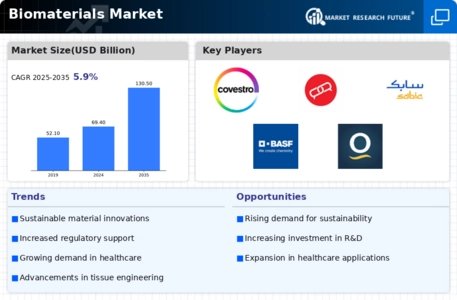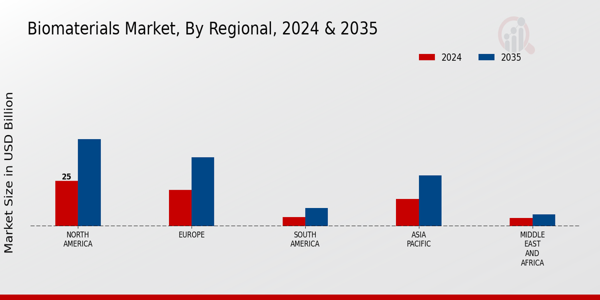-
EXECUTIVE SUMMARY
-
Market Overview
-
Key Findings
-
Market Segmentation
-
Competitive Landscape
-
Challenges and Opportunities
-
Future
-
Outlook
-
MARKET INTRODUCTION
-
Definition
-
Scope
- Research Objective
- Assumption
-
of the study
-
Limitations
-
RESEARCH METHODOLOGY
-
Overview
-
Data Mining
-
Secondary Research
-
Primary Research
- Primary Interviews
- Breakdown of Primary Respondents
-
and Information Gathering Process
-
Forecasting Model
-
Market Size Estimation
- Bottom-Up
- Top-Down Approach
-
Approach
-
Data Triangulation
-
Validation
-
MARKET DYNAMICS
-
Overview
-
Drivers
-
Restraints
-
Opportunities
-
MARKET FACTOR ANALYSIS
-
Value chain Analysis
-
Porter's Five Forces Analysis
- Bargaining Power of Buyers
- Threat of Substitutes
- Intensity
-
Bargaining Power of Suppliers
-
Threat of New Entrants
-
of Rivalry
-
COVID-19 Impact Analysis
- Market Impact Analysis
- Regional Impact
- Opportunity and Threat Analysis
-
BIOMATERIALS MARKET, BY APPLICATION (USD BILLION)
-
Medical Devices
-
Tissue Engineering
-
Drug Delivery
-
Orthopedics
-
Wound Care
-
BIOMATERIALS MARKET, BY TYPE (USD BILLION)
-
Natural Biomaterials
-
Synthetic Biomaterials
-
Modified Biomaterials
-
BIOMATERIALS MARKET, BY SOURCE (USD BILLION)
-
Plant-based
-
Animal-based
-
Microbial-based
-
BIOMATERIALS MARKET, BY
-
END USE (USD BILLION)
-
Healthcare
-
Pharmaceuticals
-
Cosmetics
-
BIOMATERIALS MARKET, BY REGIONAL (USD BILLION)
-
North
- US
- Canada
-
America
-
Europe
- Germany
- UK
- France
- Russia
- Italy
- Spain
- Rest of Europe
-
APAC
- China
- India
- Japan
- South Korea
- Thailand
- Indonesia
- Rest of APAC
-
Malaysia
-
South America
- Brazil
- Mexico
- Rest of South America
-
Argentina
-
MEA
- GCC
- South Africa
- Rest of MEA
-
Countries
-
COMPETITIVE
-
LANDSCAPE
-
Overview
-
Competitive Analysis
-
Market
-
share Analysis
-
Major Growth Strategy in the Biomaterials Market
-
Competitive Benchmarking
-
Leading Players in Terms of Number
-
of Developments in the Biomaterials Market
-
Key developments and growth
- New Product Launch/Service Deployment
- Merger
- Joint Ventures
-
strategies
-
& Acquisitions
-
Major Players Financial
- Sales and Operating Income
- Major Players R&D
-
Matrix
-
Expenditure. 2023
-
COMPANY PROFILES
-
DuPont
- Financial
- Products Offered
- Key Developments
- Key Strategies
-
Overview
-
SWOT Analysis
-
NatureWorks
- Products Offered
- Key Developments
- SWOT Analysis
- Key Strategies
-
Financial Overview
-
Merck KGaA
- Financial Overview
- Products Offered
- Key
- SWOT Analysis
- Key Strategies
- Financial Overview
- Products Offered
- Key Developments
- SWOT Analysis
- Key Strategies
-
Developments
-
Johnson and Johnson
-
Corbion
- Financial Overview
- Products Offered
- Key Developments
- SWOT Analysis
- Key Strategies
-
Zymergen
- Financial Overview
- Products Offered
- Key Developments
- SWOT Analysis
- Key Strategies
-
Mitsubishi Gas Chemical Company
- Financial Overview
- Products Offered
- Key Developments
- SWOT Analysis
- Key Strategies
-
Kraton
- Financial Overview
- Products Offered
- Key Developments
- SWOT
- Key Strategies
-
Analysis
-
Medtronic
- Financial
- Products Offered
- Key Developments
- Key Strategies
-
Overview
-
SWOT Analysis
-
BASF
- Financial
- Products Offered
- Key Developments
- Key Strategies
-
Overview
-
SWOT Analysis
-
CHT Group
- Products Offered
- Key Developments
- SWOT Analysis
- Key Strategies
-
Financial Overview
-
Tredegar
- Financial Overview
- Products Offered
- Key Developments
- SWOT Analysis
- Key Strategies
-
Corporation
-
Evonik Industries
- Financial Overview
- Key Developments
- SWOT Analysis
- Key Strategies
-
Products Offered
-
3M
- Financial Overview
- Products Offered
- Key Developments
- SWOT
- Key Strategies
-
Analysis
-
Tokyo Chemical Industry
- Financial Overview
- Products Offered
- Key
- SWOT Analysis
- Key Strategies
-
Developments
-
APPENDIX
-
References
-
Related Reports
-
LIST
-
OF TABLES
-
LIST OF ASSUMPTIONS
-
NORTH AMERICA
-
BIOMATERIALS MARKET SIZE ESTIMATES & FORECAST, BY APPLICATION, 2019-2035 (USD
-
BILLIONS)
-
NORTH AMERICA BIOMATERIALS MARKET SIZE ESTIMATES &
-
FORECAST, BY TYPE, 2019-2035 (USD BILLIONS)
-
NORTH AMERICA BIOMATERIALS
-
MARKET SIZE ESTIMATES & FORECAST, BY SOURCE, 2019-2035 (USD BILLIONS)
-
TABLE
-
NORTH AMERICA BIOMATERIALS MARKET SIZE ESTIMATES & FORECAST, BY END USE,
-
NORTH AMERICA BIOMATERIALS MARKET SIZE ESTIMATES
-
& FORECAST, BY REGIONAL, 2019-2035 (USD BILLIONS)
-
US BIOMATERIALS
-
MARKET SIZE ESTIMATES & FORECAST, BY APPLICATION, 2019-2035 (USD BILLIONS)
-
US BIOMATERIALS MARKET SIZE ESTIMATES & FORECAST, BY TYPE, 2019-2035
-
(USD BILLIONS)
-
US BIOMATERIALS MARKET SIZE ESTIMATES & FORECAST,
-
BY SOURCE, 2019-2035 (USD BILLIONS)
-
US BIOMATERIALS MARKET SIZE
-
ESTIMATES & FORECAST, BY END USE, 2019-2035 (USD BILLIONS)
-
US
-
BIOMATERIALS MARKET SIZE ESTIMATES & FORECAST, BY REGIONAL, 2019-2035 (USD BILLIONS)
-
CANADA BIOMATERIALS MARKET SIZE ESTIMATES & FORECAST, BY APPLICATION,
-
CANADA BIOMATERIALS MARKET SIZE ESTIMATES
-
& FORECAST, BY TYPE, 2019-2035 (USD BILLIONS)
-
CANADA BIOMATERIALS
-
MARKET SIZE ESTIMATES & FORECAST, BY SOURCE, 2019-2035 (USD BILLIONS)
-
TABLE
-
CANADA BIOMATERIALS MARKET SIZE ESTIMATES & FORECAST, BY END USE, 2019-2035
-
(USD BILLIONS)
-
CANADA BIOMATERIALS MARKET SIZE ESTIMATES & FORECAST,
-
BY REGIONAL, 2019-2035 (USD BILLIONS)
-
EUROPE BIOMATERIALS MARKET
-
SIZE ESTIMATES & FORECAST, BY APPLICATION, 2019-2035 (USD BILLIONS)
-
TABLE
-
EUROPE BIOMATERIALS MARKET SIZE ESTIMATES & FORECAST, BY TYPE, 2019-2035
-
(USD BILLIONS)
-
EUROPE BIOMATERIALS MARKET SIZE ESTIMATES & FORECAST,
-
BY SOURCE, 2019-2035 (USD BILLIONS)
-
EUROPE BIOMATERIALS MARKET SIZE
-
ESTIMATES & FORECAST, BY END USE, 2019-2035 (USD BILLIONS)
-
EUROPE
-
BIOMATERIALS MARKET SIZE ESTIMATES & FORECAST, BY REGIONAL, 2019-2035 (USD BILLIONS)
-
GERMANY BIOMATERIALS MARKET SIZE ESTIMATES & FORECAST, BY APPLICATION,
-
GERMANY BIOMATERIALS MARKET SIZE ESTIMATES
-
& FORECAST, BY TYPE, 2019-2035 (USD BILLIONS)
-
GERMANY BIOMATERIALS
-
MARKET SIZE ESTIMATES & FORECAST, BY SOURCE, 2019-2035 (USD BILLIONS)
-
TABLE
-
GERMANY BIOMATERIALS MARKET SIZE ESTIMATES & FORECAST, BY END USE, 2019-2035
-
(USD BILLIONS)
-
GERMANY BIOMATERIALS MARKET SIZE ESTIMATES &
-
FORECAST, BY REGIONAL, 2019-2035 (USD BILLIONS)
-
UK BIOMATERIALS
-
MARKET SIZE ESTIMATES & FORECAST, BY APPLICATION, 2019-2035 (USD BILLIONS)
-
UK BIOMATERIALS MARKET SIZE ESTIMATES & FORECAST, BY TYPE, 2019-2035
-
(USD BILLIONS)
-
UK BIOMATERIALS MARKET SIZE ESTIMATES & FORECAST,
-
BY SOURCE, 2019-2035 (USD BILLIONS)
-
UK BIOMATERIALS MARKET SIZE
-
ESTIMATES & FORECAST, BY END USE, 2019-2035 (USD BILLIONS)
-
UK
-
BIOMATERIALS MARKET SIZE ESTIMATES & FORECAST, BY REGIONAL, 2019-2035 (USD BILLIONS)
-
FRANCE BIOMATERIALS MARKET SIZE ESTIMATES & FORECAST, BY APPLICATION,
-
FRANCE BIOMATERIALS MARKET SIZE ESTIMATES
-
& FORECAST, BY TYPE, 2019-2035 (USD BILLIONS)
-
FRANCE BIOMATERIALS
-
MARKET SIZE ESTIMATES & FORECAST, BY SOURCE, 2019-2035 (USD BILLIONS)
-
TABLE
-
FRANCE BIOMATERIALS MARKET SIZE ESTIMATES & FORECAST, BY END USE, 2019-2035
-
(USD BILLIONS)
-
FRANCE BIOMATERIALS MARKET SIZE ESTIMATES & FORECAST,
-
BY REGIONAL, 2019-2035 (USD BILLIONS)
-
RUSSIA BIOMATERIALS MARKET
-
SIZE ESTIMATES & FORECAST, BY APPLICATION, 2019-2035 (USD BILLIONS)
-
TABLE
-
RUSSIA BIOMATERIALS MARKET SIZE ESTIMATES & FORECAST, BY TYPE, 2019-2035
-
(USD BILLIONS)
-
RUSSIA BIOMATERIALS MARKET SIZE ESTIMATES & FORECAST,
-
BY SOURCE, 2019-2035 (USD BILLIONS)
-
RUSSIA BIOMATERIALS MARKET SIZE
-
ESTIMATES & FORECAST, BY END USE, 2019-2035 (USD BILLIONS)
-
RUSSIA
-
BIOMATERIALS MARKET SIZE ESTIMATES & FORECAST, BY REGIONAL, 2019-2035 (USD BILLIONS)
-
ITALY BIOMATERIALS MARKET SIZE ESTIMATES & FORECAST, BY APPLICATION,
-
ITALY BIOMATERIALS MARKET SIZE ESTIMATES
-
& FORECAST, BY TYPE, 2019-2035 (USD BILLIONS)
-
ITALY BIOMATERIALS
-
MARKET SIZE ESTIMATES & FORECAST, BY SOURCE, 2019-2035 (USD BILLIONS)
-
TABLE
-
ITALY BIOMATERIALS MARKET SIZE ESTIMATES & FORECAST, BY END USE, 2019-2035
-
(USD BILLIONS)
-
ITALY BIOMATERIALS MARKET SIZE ESTIMATES & FORECAST,
-
BY REGIONAL, 2019-2035 (USD BILLIONS)
-
SPAIN BIOMATERIALS MARKET
-
SIZE ESTIMATES & FORECAST, BY APPLICATION, 2019-2035 (USD BILLIONS)
-
TABLE
-
SPAIN BIOMATERIALS MARKET SIZE ESTIMATES & FORECAST, BY TYPE, 2019-2035
-
(USD BILLIONS)
-
SPAIN BIOMATERIALS MARKET SIZE ESTIMATES & FORECAST,
-
BY SOURCE, 2019-2035 (USD BILLIONS)
-
SPAIN BIOMATERIALS MARKET SIZE
-
ESTIMATES & FORECAST, BY END USE, 2019-2035 (USD BILLIONS)
-
SPAIN
-
BIOMATERIALS MARKET SIZE ESTIMATES & FORECAST, BY REGIONAL, 2019-2035 (USD BILLIONS)
-
REST OF EUROPE BIOMATERIALS MARKET SIZE ESTIMATES & FORECAST,
-
BY APPLICATION, 2019-2035 (USD BILLIONS)
-
REST OF EUROPE BIOMATERIALS
-
MARKET SIZE ESTIMATES & FORECAST, BY TYPE, 2019-2035 (USD BILLIONS)
-
TABLE
-
REST OF EUROPE BIOMATERIALS MARKET SIZE ESTIMATES & FORECAST, BY SOURCE,
-
REST OF EUROPE BIOMATERIALS MARKET SIZE
-
ESTIMATES & FORECAST, BY END USE, 2019-2035 (USD BILLIONS)
-
REST
-
OF EUROPE BIOMATERIALS MARKET SIZE ESTIMATES & FORECAST, BY REGIONAL, 2019-2035
-
(USD BILLIONS)
-
APAC BIOMATERIALS MARKET SIZE ESTIMATES & FORECAST,
-
BY APPLICATION, 2019-2035 (USD BILLIONS)
-
APAC BIOMATERIALS MARKET
-
SIZE ESTIMATES & FORECAST, BY TYPE, 2019-2035 (USD BILLIONS)
-
TABLE 59.
-
APAC BIOMATERIALS MARKET SIZE ESTIMATES & FORECAST, BY SOURCE, 2019-2035 (USD
-
BILLIONS)
-
APAC BIOMATERIALS MARKET SIZE ESTIMATES & FORECAST,
-
BY END USE, 2019-2035 (USD BILLIONS)
-
APAC BIOMATERIALS MARKET SIZE
-
ESTIMATES & FORECAST, BY REGIONAL, 2019-2035 (USD BILLIONS)
-
TABLE 62.
-
CHINA BIOMATERIALS MARKET SIZE ESTIMATES & FORECAST, BY APPLICATION, 2019-2035
-
(USD BILLIONS)
-
CHINA BIOMATERIALS MARKET SIZE ESTIMATES & FORECAST,
-
BY TYPE, 2019-2035 (USD BILLIONS)
-
CHINA BIOMATERIALS MARKET SIZE
-
ESTIMATES & FORECAST, BY SOURCE, 2019-2035 (USD BILLIONS)
-
CHINA
-
BIOMATERIALS MARKET SIZE ESTIMATES & FORECAST, BY END USE, 2019-2035 (USD BILLIONS)
-
CHINA BIOMATERIALS MARKET SIZE ESTIMATES & FORECAST, BY REGIONAL,
-
INDIA BIOMATERIALS MARKET SIZE ESTIMATES
-
& FORECAST, BY APPLICATION, 2019-2035 (USD BILLIONS)
-
INDIA BIOMATERIALS
-
MARKET SIZE ESTIMATES & FORECAST, BY TYPE, 2019-2035 (USD BILLIONS)
-
TABLE
-
INDIA BIOMATERIALS MARKET SIZE ESTIMATES & FORECAST, BY SOURCE, 2019-2035
-
(USD BILLIONS)
-
INDIA BIOMATERIALS MARKET SIZE ESTIMATES & FORECAST,
-
BY END USE, 2019-2035 (USD BILLIONS)
-
INDIA BIOMATERIALS MARKET SIZE
-
ESTIMATES & FORECAST, BY REGIONAL, 2019-2035 (USD BILLIONS)
-
TABLE 72.
-
JAPAN BIOMATERIALS MARKET SIZE ESTIMATES & FORECAST, BY APPLICATION, 2019-2035
-
(USD BILLIONS)
-
JAPAN BIOMATERIALS MARKET SIZE ESTIMATES & FORECAST,
-
BY TYPE, 2019-2035 (USD BILLIONS)
-
JAPAN BIOMATERIALS MARKET SIZE
-
ESTIMATES & FORECAST, BY SOURCE, 2019-2035 (USD BILLIONS)
-
JAPAN
-
BIOMATERIALS MARKET SIZE ESTIMATES & FORECAST, BY END USE, 2019-2035 (USD BILLIONS)
-
JAPAN BIOMATERIALS MARKET SIZE ESTIMATES & FORECAST, BY REGIONAL,
-
SOUTH KOREA BIOMATERIALS MARKET SIZE ESTIMATES
-
& FORECAST, BY APPLICATION, 2019-2035 (USD BILLIONS)
-
SOUTH KOREA
-
BIOMATERIALS MARKET SIZE ESTIMATES & FORECAST, BY TYPE, 2019-2035 (USD BILLIONS)
-
SOUTH KOREA BIOMATERIALS MARKET SIZE ESTIMATES & FORECAST, BY
-
SOURCE, 2019-2035 (USD BILLIONS)
-
SOUTH KOREA BIOMATERIALS MARKET
-
SIZE ESTIMATES & FORECAST, BY END USE, 2019-2035 (USD BILLIONS)
-
TABLE
-
SOUTH KOREA BIOMATERIALS MARKET SIZE ESTIMATES & FORECAST, BY REGIONAL,
-
MALAYSIA BIOMATERIALS MARKET SIZE ESTIMATES
-
& FORECAST, BY APPLICATION, 2019-2035 (USD BILLIONS)
-
MALAYSIA
-
BIOMATERIALS MARKET SIZE ESTIMATES & FORECAST, BY TYPE, 2019-2035 (USD BILLIONS)
-
MALAYSIA BIOMATERIALS MARKET SIZE ESTIMATES & FORECAST, BY SOURCE,
-
MALAYSIA BIOMATERIALS MARKET SIZE ESTIMATES
-
& FORECAST, BY END USE, 2019-2035 (USD BILLIONS)
-
MALAYSIA BIOMATERIALS
-
MARKET SIZE ESTIMATES & FORECAST, BY REGIONAL, 2019-2035 (USD BILLIONS)
-
THAILAND BIOMATERIALS MARKET SIZE ESTIMATES & FORECAST, BY APPLICATION,
-
THAILAND BIOMATERIALS MARKET SIZE ESTIMATES
-
& FORECAST, BY TYPE, 2019-2035 (USD BILLIONS)
-
THAILAND BIOMATERIALS
-
MARKET SIZE ESTIMATES & FORECAST, BY SOURCE, 2019-2035 (USD BILLIONS)
-
TABLE
-
THAILAND BIOMATERIALS MARKET SIZE ESTIMATES & FORECAST, BY END USE, 2019-2035
-
(USD BILLIONS)
-
THAILAND BIOMATERIALS MARKET SIZE ESTIMATES &
-
FORECAST, BY REGIONAL, 2019-2035 (USD BILLIONS)
-
INDONESIA BIOMATERIALS
-
MARKET SIZE ESTIMATES & FORECAST, BY APPLICATION, 2019-2035 (USD BILLIONS)
-
INDONESIA BIOMATERIALS MARKET SIZE ESTIMATES & FORECAST, BY TYPE,
-
INDONESIA BIOMATERIALS MARKET SIZE ESTIMATES
-
& FORECAST, BY SOURCE, 2019-2035 (USD BILLIONS)
-
INDONESIA BIOMATERIALS
-
MARKET SIZE ESTIMATES & FORECAST, BY END USE, 2019-2035 (USD BILLIONS)
-
TABLE
-
INDONESIA BIOMATERIALS MARKET SIZE ESTIMATES & FORECAST, BY REGIONAL, 2019-2035
-
(USD BILLIONS)
-
REST OF APAC BIOMATERIALS MARKET SIZE ESTIMATES &
-
FORECAST, BY APPLICATION, 2019-2035 (USD BILLIONS)
-
REST OF APAC
-
BIOMATERIALS MARKET SIZE ESTIMATES & FORECAST, BY TYPE, 2019-2035 (USD BILLIONS)
-
REST OF APAC BIOMATERIALS MARKET SIZE ESTIMATES & FORECAST,
-
BY SOURCE, 2019-2035 (USD BILLIONS)
-
REST OF APAC BIOMATERIALS MARKET
-
SIZE ESTIMATES & FORECAST, BY END USE, 2019-2035 (USD BILLIONS)
-
TABLE
-
REST OF APAC BIOMATERIALS MARKET SIZE ESTIMATES & FORECAST, BY REGIONAL,
-
SOUTH AMERICA BIOMATERIALS MARKET SIZE
-
ESTIMATES & FORECAST, BY APPLICATION, 2019-2035 (USD BILLIONS)
-
TABLE 103.
-
SOUTH AMERICA BIOMATERIALS MARKET SIZE ESTIMATES & FORECAST, BY TYPE, 2019-2035
-
(USD BILLIONS)
-
SOUTH AMERICA BIOMATERIALS MARKET SIZE ESTIMATES
-
& FORECAST, BY SOURCE, 2019-2035 (USD BILLIONS)
-
SOUTH AMERICA
-
BIOMATERIALS MARKET SIZE ESTIMATES & FORECAST, BY END USE, 2019-2035 (USD BILLIONS)
-
SOUTH AMERICA BIOMATERIALS MARKET SIZE ESTIMATES & FORECAST,
-
BY REGIONAL, 2019-2035 (USD BILLIONS)
-
BRAZIL BIOMATERIALS MARKET
-
SIZE ESTIMATES & FORECAST, BY APPLICATION, 2019-2035 (USD BILLIONS)
-
TABLE
-
BRAZIL BIOMATERIALS MARKET SIZE ESTIMATES & FORECAST, BY TYPE, 2019-2035
-
(USD BILLIONS)
-
BRAZIL BIOMATERIALS MARKET SIZE ESTIMATES &
-
FORECAST, BY SOURCE, 2019-2035 (USD BILLIONS)
-
BRAZIL BIOMATERIALS
-
MARKET SIZE ESTIMATES & FORECAST, BY END USE, 2019-2035 (USD BILLIONS)
-
TABLE
-
BRAZIL BIOMATERIALS MARKET SIZE ESTIMATES & FORECAST, BY REGIONAL, 2019-2035
-
(USD BILLIONS)
-
MEXICO BIOMATERIALS MARKET SIZE ESTIMATES &
-
FORECAST, BY APPLICATION, 2019-2035 (USD BILLIONS)
-
MEXICO BIOMATERIALS
-
MARKET SIZE ESTIMATES & FORECAST, BY TYPE, 2019-2035 (USD BILLIONS)
-
TABLE
-
MEXICO BIOMATERIALS MARKET SIZE ESTIMATES & FORECAST, BY SOURCE, 2019-2035
-
(USD BILLIONS)
-
MEXICO BIOMATERIALS MARKET SIZE ESTIMATES &
-
FORECAST, BY END USE, 2019-2035 (USD BILLIONS)
-
MEXICO BIOMATERIALS
-
MARKET SIZE ESTIMATES & FORECAST, BY REGIONAL, 2019-2035 (USD BILLIONS)
-
ARGENTINA BIOMATERIALS MARKET SIZE ESTIMATES & FORECAST, BY APPLICATION,
-
ARGENTINA BIOMATERIALS MARKET SIZE ESTIMATES
-
& FORECAST, BY TYPE, 2019-2035 (USD BILLIONS)
-
ARGENTINA BIOMATERIALS
-
MARKET SIZE ESTIMATES & FORECAST, BY SOURCE, 2019-2035 (USD BILLIONS)
-
TABLE
-
ARGENTINA BIOMATERIALS MARKET SIZE ESTIMATES & FORECAST, BY END USE, 2019-2035
-
(USD BILLIONS)
-
ARGENTINA BIOMATERIALS MARKET SIZE ESTIMATES &
-
FORECAST, BY REGIONAL, 2019-2035 (USD BILLIONS)
-
REST OF SOUTH AMERICA
-
BIOMATERIALS MARKET SIZE ESTIMATES & FORECAST, BY APPLICATION, 2019-2035 (USD
-
BILLIONS)
-
REST OF SOUTH AMERICA BIOMATERIALS MARKET SIZE ESTIMATES
-
& FORECAST, BY TYPE, 2019-2035 (USD BILLIONS)
-
REST OF SOUTH
-
AMERICA BIOMATERIALS MARKET SIZE ESTIMATES & FORECAST, BY SOURCE, 2019-2035
-
(USD BILLIONS)
-
REST OF SOUTH AMERICA BIOMATERIALS MARKET SIZE ESTIMATES
-
& FORECAST, BY END USE, 2019-2035 (USD BILLIONS)
-
REST OF SOUTH
-
AMERICA BIOMATERIALS MARKET SIZE ESTIMATES & FORECAST, BY REGIONAL, 2019-2035
-
(USD BILLIONS)
-
MEA BIOMATERIALS MARKET SIZE ESTIMATES & FORECAST,
-
BY APPLICATION, 2019-2035 (USD BILLIONS)
-
MEA BIOMATERIALS MARKET
-
SIZE ESTIMATES & FORECAST, BY TYPE, 2019-2035 (USD BILLIONS)
-
TABLE 129.
-
MEA BIOMATERIALS MARKET SIZE ESTIMATES & FORECAST, BY SOURCE, 2019-2035 (USD
-
BILLIONS)
-
MEA BIOMATERIALS MARKET SIZE ESTIMATES & FORECAST,
-
BY END USE, 2019-2035 (USD BILLIONS)
-
MEA BIOMATERIALS MARKET SIZE
-
ESTIMATES & FORECAST, BY REGIONAL, 2019-2035 (USD BILLIONS)
-
TABLE 132.
-
GCC COUNTRIES BIOMATERIALS MARKET SIZE ESTIMATES & FORECAST, BY APPLICATION,
-
GCC COUNTRIES BIOMATERIALS MARKET SIZE
-
ESTIMATES & FORECAST, BY TYPE, 2019-2035 (USD BILLIONS)
-
GCC
-
COUNTRIES BIOMATERIALS MARKET SIZE ESTIMATES & FORECAST, BY SOURCE, 2019-2035
-
(USD BILLIONS)
-
GCC COUNTRIES BIOMATERIALS MARKET SIZE ESTIMATES
-
& FORECAST, BY END USE, 2019-2035 (USD BILLIONS)
-
GCC COUNTRIES
-
BIOMATERIALS MARKET SIZE ESTIMATES & FORECAST, BY REGIONAL, 2019-2035 (USD BILLIONS)
-
SOUTH AFRICA BIOMATERIALS MARKET SIZE ESTIMATES & FORECAST,
-
BY APPLICATION, 2019-2035 (USD BILLIONS)
-
SOUTH AFRICA BIOMATERIALS
-
MARKET SIZE ESTIMATES & FORECAST, BY TYPE, 2019-2035 (USD BILLIONS)
-
TABLE
-
SOUTH AFRICA BIOMATERIALS MARKET SIZE ESTIMATES & FORECAST, BY SOURCE,
-
SOUTH AFRICA BIOMATERIALS MARKET SIZE
-
ESTIMATES & FORECAST, BY END USE, 2019-2035 (USD BILLIONS)
-
TABLE 141.
-
SOUTH AFRICA BIOMATERIALS MARKET SIZE ESTIMATES & FORECAST, BY REGIONAL, 2019-2035
-
(USD BILLIONS)
-
REST OF MEA BIOMATERIALS MARKET SIZE ESTIMATES &
-
FORECAST, BY APPLICATION, 2019-2035 (USD BILLIONS)
-
REST OF MEA
-
BIOMATERIALS MARKET SIZE ESTIMATES & FORECAST, BY TYPE, 2019-2035 (USD BILLIONS)
-
REST OF MEA BIOMATERIALS MARKET SIZE ESTIMATES & FORECAST,
-
BY SOURCE, 2019-2035 (USD BILLIONS)
-
REST OF MEA BIOMATERIALS MARKET
-
SIZE ESTIMATES & FORECAST, BY END USE, 2019-2035 (USD BILLIONS)
-
TABLE
-
REST OF MEA BIOMATERIALS MARKET SIZE ESTIMATES & FORECAST, BY REGIONAL,
-
PRODUCT LAUNCH/PRODUCT DEVELOPMENT/APPROVAL
-
ACQUISITION/PARTNERSHIP
-
LIST OF FIGURES
-
MARKET SYNOPSIS
-
NORTH AMERICA BIOMATERIALS MARKET ANALYSIS
-
US BIOMATERIALS MARKET ANALYSIS BY APPLICATION
-
US
-
BIOMATERIALS MARKET ANALYSIS BY TYPE
-
US BIOMATERIALS MARKET ANALYSIS
-
BY SOURCE
-
US BIOMATERIALS MARKET ANALYSIS BY END USE
-
FIGURE
-
US BIOMATERIALS MARKET ANALYSIS BY REGIONAL
-
CANADA BIOMATERIALS
-
MARKET ANALYSIS BY APPLICATION
-
CANADA BIOMATERIALS MARKET ANALYSIS
-
BY TYPE
-
CANADA BIOMATERIALS MARKET ANALYSIS BY SOURCE
-
FIGURE
-
CANADA BIOMATERIALS MARKET ANALYSIS BY END USE
-
CANADA BIOMATERIALS
-
MARKET ANALYSIS BY REGIONAL
-
EUROPE BIOMATERIALS MARKET ANALYSIS
-
GERMANY BIOMATERIALS MARKET ANALYSIS BY APPLICATION
-
FIGURE
-
GERMANY BIOMATERIALS MARKET ANALYSIS BY TYPE
-
GERMANY BIOMATERIALS
-
MARKET ANALYSIS BY SOURCE
-
GERMANY BIOMATERIALS MARKET ANALYSIS
-
BY END USE
-
GERMANY BIOMATERIALS MARKET ANALYSIS BY REGIONAL
-
UK BIOMATERIALS MARKET ANALYSIS BY APPLICATION
-
UK
-
BIOMATERIALS MARKET ANALYSIS BY TYPE
-
UK BIOMATERIALS MARKET ANALYSIS
-
BY SOURCE
-
UK BIOMATERIALS MARKET ANALYSIS BY END USE
-
FIGURE
-
UK BIOMATERIALS MARKET ANALYSIS BY REGIONAL
-
FRANCE BIOMATERIALS
-
MARKET ANALYSIS BY APPLICATION
-
FRANCE BIOMATERIALS MARKET ANALYSIS
-
BY TYPE
-
FRANCE BIOMATERIALS MARKET ANALYSIS BY SOURCE
-
FIGURE
-
FRANCE BIOMATERIALS MARKET ANALYSIS BY END USE
-
FRANCE BIOMATERIALS
-
MARKET ANALYSIS BY REGIONAL
-
RUSSIA BIOMATERIALS MARKET ANALYSIS
-
BY APPLICATION
-
RUSSIA BIOMATERIALS MARKET ANALYSIS BY TYPE
-
RUSSIA BIOMATERIALS MARKET ANALYSIS BY SOURCE
-
RUSSIA
-
BIOMATERIALS MARKET ANALYSIS BY END USE
-
RUSSIA BIOMATERIALS MARKET
-
ANALYSIS BY REGIONAL
-
ITALY BIOMATERIALS MARKET ANALYSIS BY APPLICATION
-
ITALY BIOMATERIALS MARKET ANALYSIS BY TYPE
-
ITALY
-
BIOMATERIALS MARKET ANALYSIS BY SOURCE
-
ITALY BIOMATERIALS MARKET
-
ANALYSIS BY END USE
-
ITALY BIOMATERIALS MARKET ANALYSIS BY REGIONAL
-
SPAIN BIOMATERIALS MARKET ANALYSIS BY APPLICATION
-
FIGURE
-
SPAIN BIOMATERIALS MARKET ANALYSIS BY TYPE
-
SPAIN BIOMATERIALS
-
MARKET ANALYSIS BY SOURCE
-
SPAIN BIOMATERIALS MARKET ANALYSIS BY
-
END USE
-
SPAIN BIOMATERIALS MARKET ANALYSIS BY REGIONAL
-
FIGURE
-
REST OF EUROPE BIOMATERIALS MARKET ANALYSIS BY APPLICATION
-
FIGURE 45.
-
REST OF EUROPE BIOMATERIALS MARKET ANALYSIS BY TYPE
-
REST OF EUROPE
-
BIOMATERIALS MARKET ANALYSIS BY SOURCE
-
REST OF EUROPE BIOMATERIALS
-
MARKET ANALYSIS BY END USE
-
REST OF EUROPE BIOMATERIALS MARKET ANALYSIS
-
BY REGIONAL
-
APAC BIOMATERIALS MARKET ANALYSIS
-
FIGURE 50.
-
CHINA BIOMATERIALS MARKET ANALYSIS BY APPLICATION
-
CHINA BIOMATERIALS
-
MARKET ANALYSIS BY TYPE
-
CHINA BIOMATERIALS MARKET ANALYSIS BY SOURCE
-
CHINA BIOMATERIALS MARKET ANALYSIS BY END USE
-
FIGURE 54.
-
CHINA BIOMATERIALS MARKET ANALYSIS BY REGIONAL
-
INDIA BIOMATERIALS
-
MARKET ANALYSIS BY APPLICATION
-
INDIA BIOMATERIALS MARKET ANALYSIS
-
BY TYPE
-
INDIA BIOMATERIALS MARKET ANALYSIS BY SOURCE
-
FIGURE
-
INDIA BIOMATERIALS MARKET ANALYSIS BY END USE
-
INDIA BIOMATERIALS
-
MARKET ANALYSIS BY REGIONAL
-
JAPAN BIOMATERIALS MARKET ANALYSIS
-
BY APPLICATION
-
JAPAN BIOMATERIALS MARKET ANALYSIS BY TYPE
-
FIGURE
-
JAPAN BIOMATERIALS MARKET ANALYSIS BY SOURCE
-
JAPAN BIOMATERIALS
-
MARKET ANALYSIS BY END USE
-
JAPAN BIOMATERIALS MARKET ANALYSIS BY
-
REGIONAL
-
SOUTH KOREA BIOMATERIALS MARKET ANALYSIS BY APPLICATION
-
SOUTH KOREA BIOMATERIALS MARKET ANALYSIS BY TYPE
-
FIGURE 67.
-
SOUTH KOREA BIOMATERIALS MARKET ANALYSIS BY SOURCE
-
SOUTH KOREA
-
BIOMATERIALS MARKET ANALYSIS BY END USE
-
SOUTH KOREA BIOMATERIALS
-
MARKET ANALYSIS BY REGIONAL
-
MALAYSIA BIOMATERIALS MARKET ANALYSIS
-
BY APPLICATION
-
MALAYSIA BIOMATERIALS MARKET ANALYSIS BY TYPE
-
MALAYSIA BIOMATERIALS MARKET ANALYSIS BY SOURCE
-
MALAYSIA
-
BIOMATERIALS MARKET ANALYSIS BY END USE
-
MALAYSIA BIOMATERIALS MARKET
-
ANALYSIS BY REGIONAL
-
THAILAND BIOMATERIALS MARKET ANALYSIS BY APPLICATION
-
THAILAND BIOMATERIALS MARKET ANALYSIS BY TYPE
-
FIGURE 77.
-
THAILAND BIOMATERIALS MARKET ANALYSIS BY SOURCE
-
THAILAND BIOMATERIALS
-
MARKET ANALYSIS BY END USE
-
THAILAND BIOMATERIALS MARKET ANALYSIS
-
BY REGIONAL
-
INDONESIA BIOMATERIALS MARKET ANALYSIS BY APPLICATION
-
INDONESIA BIOMATERIALS MARKET ANALYSIS BY TYPE
-
FIGURE 82.
-
INDONESIA BIOMATERIALS MARKET ANALYSIS BY SOURCE
-
INDONESIA BIOMATERIALS
-
MARKET ANALYSIS BY END USE
-
INDONESIA BIOMATERIALS MARKET ANALYSIS
-
BY REGIONAL
-
REST OF APAC BIOMATERIALS MARKET ANALYSIS BY APPLICATION
-
REST OF APAC BIOMATERIALS MARKET ANALYSIS BY TYPE
-
FIGURE
-
REST OF APAC BIOMATERIALS MARKET ANALYSIS BY SOURCE
-
REST OF
-
APAC BIOMATERIALS MARKET ANALYSIS BY END USE
-
REST OF APAC BIOMATERIALS
-
MARKET ANALYSIS BY REGIONAL
-
SOUTH AMERICA BIOMATERIALS MARKET ANALYSIS
-
BRAZIL BIOMATERIALS MARKET ANALYSIS BY APPLICATION
-
FIGURE
-
BRAZIL BIOMATERIALS MARKET ANALYSIS BY TYPE
-
BRAZIL BIOMATERIALS
-
MARKET ANALYSIS BY SOURCE
-
BRAZIL BIOMATERIALS MARKET ANALYSIS BY
-
END USE
-
BRAZIL BIOMATERIALS MARKET ANALYSIS BY REGIONAL
-
FIGURE
-
MEXICO BIOMATERIALS MARKET ANALYSIS BY APPLICATION
-
MEXICO BIOMATERIALS
-
MARKET ANALYSIS BY TYPE
-
MEXICO BIOMATERIALS MARKET ANALYSIS BY
-
SOURCE
-
MEXICO BIOMATERIALS MARKET ANALYSIS BY END USE
-
FIGURE
-
MEXICO BIOMATERIALS MARKET ANALYSIS BY REGIONAL
-
ARGENTINA
-
BIOMATERIALS MARKET ANALYSIS BY APPLICATION
-
ARGENTINA BIOMATERIALS
-
MARKET ANALYSIS BY TYPE
-
ARGENTINA BIOMATERIALS MARKET ANALYSIS
-
BY SOURCE
-
ARGENTINA BIOMATERIALS MARKET ANALYSIS BY END USE
-
ARGENTINA BIOMATERIALS MARKET ANALYSIS BY REGIONAL
-
FIGURE 106.
-
REST OF SOUTH AMERICA BIOMATERIALS MARKET ANALYSIS BY APPLICATION
-
FIGURE 107.
-
REST OF SOUTH AMERICA BIOMATERIALS MARKET ANALYSIS BY TYPE
-
REST
-
OF SOUTH AMERICA BIOMATERIALS MARKET ANALYSIS BY SOURCE
-
REST OF
-
SOUTH AMERICA BIOMATERIALS MARKET ANALYSIS BY END USE
-
REST OF
-
SOUTH AMERICA BIOMATERIALS MARKET ANALYSIS BY REGIONAL
-
MEA BIOMATERIALS
-
MARKET ANALYSIS
-
GCC COUNTRIES BIOMATERIALS MARKET ANALYSIS BY
-
APPLICATION
-
GCC COUNTRIES BIOMATERIALS MARKET ANALYSIS BY TYPE
-
GCC COUNTRIES BIOMATERIALS MARKET ANALYSIS BY SOURCE
-
FIGURE
-
GCC COUNTRIES BIOMATERIALS MARKET ANALYSIS BY END USE
-
GCC
-
COUNTRIES BIOMATERIALS MARKET ANALYSIS BY REGIONAL
-
SOUTH AFRICA
-
BIOMATERIALS MARKET ANALYSIS BY APPLICATION
-
SOUTH AFRICA BIOMATERIALS
-
MARKET ANALYSIS BY TYPE
-
SOUTH AFRICA BIOMATERIALS MARKET ANALYSIS
-
BY SOURCE
-
SOUTH AFRICA BIOMATERIALS MARKET ANALYSIS BY END USE
-
SOUTH AFRICA BIOMATERIALS MARKET ANALYSIS BY REGIONAL
-
FIGURE
-
REST OF MEA BIOMATERIALS MARKET ANALYSIS BY APPLICATION
-
REST
-
OF MEA BIOMATERIALS MARKET ANALYSIS BY TYPE
-
REST OF MEA BIOMATERIALS
-
MARKET ANALYSIS BY SOURCE
-
REST OF MEA BIOMATERIALS MARKET ANALYSIS
-
BY END USE
-
REST OF MEA BIOMATERIALS MARKET ANALYSIS BY REGIONAL
-
KEY BUYING CRITERIA OF BIOMATERIALS MARKET
-
RESEARCH
-
PROCESS OF MRFR
-
DRO ANALYSIS OF BIOMATERIALS MARKET
-
FIGURE
-
DRIVERS IMPACT ANALYSIS: BIOMATERIALS MARKET
-
RESTRAINTS IMPACT
-
ANALYSIS: BIOMATERIALS MARKET
-
SUPPLY / VALUE CHAIN: BIOMATERIALS
-
MARKET
-
BIOMATERIALS MARKET, BY APPLICATION, 2025 (% SHARE)
-
BIOMATERIALS MARKET, BY APPLICATION, 2019 TO 2035 (USD Billions)
-
BIOMATERIALS MARKET, BY TYPE, 2025 (% SHARE)
-
BIOMATERIALS
-
MARKET, BY TYPE, 2019 TO 2035 (USD Billions)
-
BIOMATERIALS MARKET,
-
BY SOURCE, 2025 (% SHARE)
-
BIOMATERIALS MARKET, BY SOURCE, 2019
-
TO 2035 (USD Billions)
-
BIOMATERIALS MARKET, BY END USE, 2025 (%
-
SHARE)
-
BIOMATERIALS MARKET, BY END USE, 2019 TO 2035 (USD Billions)
-
BIOMATERIALS MARKET, BY REGIONAL, 2025 (% SHARE)
-
FIGURE
-
BIOMATERIALS MARKET, BY REGIONAL, 2019 TO 2035 (USD Billions)
-
FIGURE
-
BENCHMARKING OF MAJOR COMPETITORS

















Leave a Comment